For years, I’ve been obsessed with planners. There’s something so satisfying about organizing your thoughts and schedule on paper. But did you know you can make money selling planners? This post covers how to create a planner to sell, from idea to profit.

This blog post is all about how to create a planner to sell.
Home > Etsy Biz > How To Create A Planner To Sell
DISCLOSURE: This is not a sponsored post. I may receive a commission through my links if you decide to make purchases at no cost for yourself! Check out our disclaimer for more info on how it works.
Table of contents
Deciding on Your Niche and Planner Type
While general planners have their audience, a niche helps focus your design and target specific customer needs. Think about your ideal customer and their organizational challenges. A teacher planner could include lesson planning sections and communication logs.
A fitness planner might focus on workout routines and habit trackers. Choose a planner type: printable, digital, or physical. Printable planners are PDFs customers print, offering instant access.
Digital planners work on tablets, using technology. Paper planners offer a tangible experience. Each type has unique production and selling strategies, affecting your pricing.

Designing Your Planner
Style and Layout
Now for the fun part: design. Create a consistent style reflecting your brand. Consider minimalist versus decorative and bold versus muted colors.
Choose color schemes, fonts, and graphic elements. Offer weekly, daily, or hourly layouts to suit various scheduling preferences. Think about different formats: daily breakdowns, weekly dashboards, or habit tracker spreads.
Essential Planner Components
Most planners have yearly, monthly, and daily/weekly spreads. These offer space for appointments, tasks, and notes, promoting a sense of organization. Include enough space for daily needs.
Adding Value with Unique Features
Go beyond the basics with niche-specific features. A teacher planner could include grading spaces and parent communication logs. A small business owner planner might have goal-setting pages and business dashboards. Consider adding popular planner features such as monthly spreads.
Creating Your Planner From Scratch
Software Options
Canva, especially the pro plan, is great for planner creation, offering easy resizing. Planify Pro provides planner-specific design elements. Designing from scratch offers more control over branding and niche alignment than planner templates.
Some prefer PowerPoint, Affinity Pro, or Keynote. There’s a free workshop if you’re interested in learning more about planner templates.
Design Process
Focus on cover design, fonts, graphics, color schemes, and extra pages. Keep your target audience and branding in mind. For paper planners, consider hardcover/softcover, paper type, and binding (spiral, stitched, or glue).
These details impact the user experience. For printable planners, ensure designs convert seamlessly to PDF. For digital planners, check compatibility across tablets and stylus pens. Consider creating custom planner options.
Production and Sales
How to Create a Planner to Sell: Physical Products
Selling paper planners requires printing. You could invest in professional equipment, considering factors like bleed, trim lines, and ink quality. Alternatively, use a print-on-demand service like Printful. Factor in costs for printing at home versus higher quantity discounts at printing plants.
How to Create a Planner to Sell: Digital Products
Consider selling on Etsy or Amazon. Etsy is known for unique creations, requiring high-quality mockups and compelling descriptions. You’ll need to navigate Etsy’s regulations, payment processes, and listing structures. Make sure your product photos are optimized to attract customers.
Amazon KDP is user-friendly but also requires strong titles, tags, and descriptions. Consider offering both editable and non-editable versions of digital products. You can also sell digital planner templates on Creative Market with a commercial license.
Selling through your own Etsy shop or website offers maximum flexibility. However, gaining visibility might be challenging as customers often search on marketplaces. Learn how to maintain consistency across different platforms.
Marketing Your Planner
Promote your planner through engaging social media posts with high-quality images. Collaborate with related businesses or bloggers. Use targeted Facebook ads to reach potential customers.
If selling on Etsy, understand their algorithm. Selling Canva templates limits your marketing potential as those buyers often seek quick fixes. Learn about editable versus non-editable digital planners to diversify your offerings.
Conclusion
Creating a planner to sell involves planning, creativity, and smart execution. By identifying a need, designing an appealing planner, and choosing the right sales platform, you can turn your passion for organization into a thriving business.
Selling digital products or physical products is possible in today’s digital age, with ample information available.
RELATED POST:
- 300+ Etsy Store Name Ideas & A Step-by-Step Guide to Picking the Perfect One (That You Can Trademark!)
- 15 Creative Ideas to Make Your Etsy Packaging Stand Out!
- Understanding Essential Requirements Before Starting Your Business: A Comprehensive Guide
- Trends on Etsy: What’s Hot and How to Find the Best-Selling Products
- Most Popular Etsy Product Categories
📌 Did you find this post helpful? Want to come back to it later? Save THIS PIN to reference later!


+ show Comments
- Hide Comments
add a comment